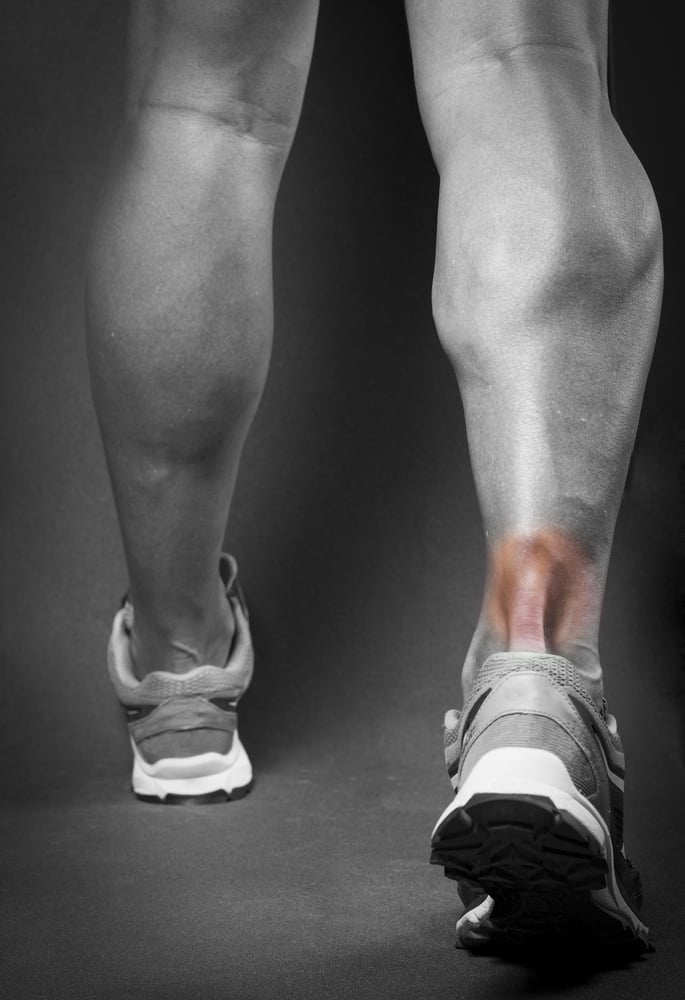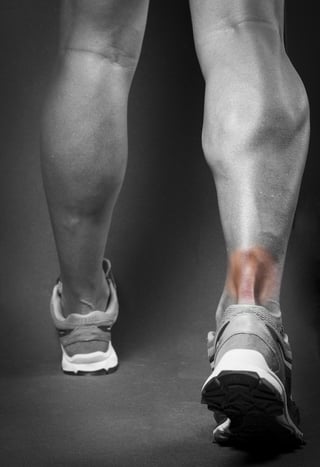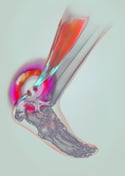Achilles Tendon injuries: Signs, Symptoms, and Causes
August 21st, 2019 | 4 min. read


Is your Achilles tendon causing you pain? You may have an injury that needs treatment. Learn about the types of Achilles tendon injuries that exist and how to recognize them.
Achilles Tendon Injury: Signs & Symptoms
The Achilles tendon, or calcaneal tendon, is a long, thick cord that runs along the back of the leg and connects the calf muscles to the heel bone or calcaneus. Together, the calf muscles and tendon and the allow your ankle to flex downward (bringing your toes away from your shin).
Though it's the thickest tendon in the body and quite strong, its constant use during walking makes it one of the most injury-prone tendons in the body. Athletes often strain or even tear or rupture an Achilles tendon when jumping, running, or making sudden, powerful, pushing-off movements. Non-athletes are more likely to hurt their Achilles tendons by wearing unsupportive footwear, twisting an ankle, or intensifying a new exercise program too quickly. Whether you are an athlete or not — how will you know if you've injured your Achilles tendon?
Symptoms of Achilles tendon injury
- Aching or burning pain and stiffness along the tendon or the back of the heel, particularly in the morning
- Pain in the tendon that gets worse with activity
- Pain in the tendon the day after activity
- A lump, bump, or knot on the tendon that you can see or feel
- Thickening of the tendon
- Stiffness or tightness in the back of the ankle; limited range of motion; difficulty flexing the foot
- Swelling that is always present, but which worsens with activity
Common Achilles tendon injuries
Achilles tendon injuries are not all the same. Some symptoms can be managed with RICE therapy (rest, ice, compression, and elevation) until the injury heals itself. Other injuries may require physical therapy or surgery.
Achilles tendinitis (also spelled "tendonitis")
 Achilles tendinitis is inflammation of the Achilles tendon or the sheath surrounding it, usually resulting in pain at the back of the ankle or heel. It is most often an overuse injury and is considered acute rather than chronic (tendinosis, described below, is chronic).
Achilles tendinitis is inflammation of the Achilles tendon or the sheath surrounding it, usually resulting in pain at the back of the ankle or heel. It is most often an overuse injury and is considered acute rather than chronic (tendinosis, described below, is chronic).
You may develop Achilles tendinitis if you overtrain or do too much too soon — for example, if you begin running long-distance without gradually increasing your mileage. Having tight calf muscles can also contribute to this injury; tight muscles can put too much strain on the tendon.
The two types of Achilles tendinitis are:
- Noninsertional Achilles Tendinitis, where fibers in the middle section of the tendon develop micro-tears. These cause swelling and thickening in the tendon. Athletes and younger people more commonly get this type of Achilles injury.
- Insertional Achilles Tendinitis, which affects the heel where the tendon attaches to the heel bone. Bone spurs (extra growths of bone) may also form. This type of tendinitis can happen to anyone, whether you are active or not.
In some cases, Achilles tendinitis can lead to damaged tendon fibers calcifying (hardening). If you have Achilles tendinitis, you may be at risk for a tendon tear or rupture in the near future.
Treatment of tendinitis usually starts out with conservative management of the injury: limiting activity, immobilizing the tendon, stretching and doing heel lifts, or taking anti-inflammatory medications. If the Achilles injury doesn't respond to these approaches within a few months, physical therapy may be helpful. Special shoe inserts (orthotics) to raise the heel or support the arch of the foot may also be beneficial.
Achilles tendinosis (also spelled "tendonosis"; sometimes called "tendinopathy")
Tendinosis is the term used to describe chronic degeneration of the collagen fibers of your Achilles tendon. The damage to your tendon happens at the cellular level. Tiny micro-tears occur, usually in the mid-portion of the tendon at the back of the calf. Your body tries to heal itself, which increases blood flow and cell repair production at the site of the injury.
Typically, tendinosis does not involve inflammation, though an examination with MRI or ultrasound may reveal that your tendon is thickened. Symptoms can include tightness and stiffness of the calf, pain, and swelling.
Achilles tendinosis is often age-related, affecting individuals who are middle-aged or older. It is sometimes found in individuals with arthritis or with vascular (blood flow) issues.
If you're diagnosed with this form of Achilles tendon degeneration, you may be at higher risk for a calf muscle tear in the future.
Often, patients with tendinosis who are having trouble walking require surgical intervention to remove scar tissue and repair micro-tears.

Achilles tendon tear
A partial tear of the Achilles tendon can result from over training or activity. Full thickness tears can happen suddenly as the result of activity, or they can result from tendinitis getting worse over time. If you suddenly have trouble walking, putting weight on your foot, or flexing your ankle, you may have a tear. Some minor tears heal on their own with rest and corrective footwear. However, if you experience symptoms of an Achilles tear, see an orthopedist; partial tears can develop into full ruptures. Achilles tendon ruptures can generally be treated with immobilization or surgery.
causes of Achilles tendon injury
Contributors to Achilles problems include:
- flat feet/fallen arches and over pronation (an inward rolling of the foot when the heel strikes the ground); the way the foot strikes the ground may over-stretch the muscles and tendons
- tight leg tendons and muscles
- sudden changes in activity level
- overtraining
Sports where Achilles injuries are common:
- Baseball and softball
- Basketball
- Dance
- Diving
- Football
- Gymnastics
- Jogging and running
- Tennis
- Track and field/cross country
- Volleyball
healing your Achilles tendon
If your Achilles has been bothering you, see an orthopedic specialist to discuss your options. How you choose to heal and rehab your Achilles tendon injury depends on factors like age, activity level, general health, and the architecture of your foot.
Your orthopedist may recommend a mix of treatment and rehab techniques, including (but not limited to):
- wearing a brace
- taping your ankle
- sleeping with night splints
- changing your footwear
- wearing orthotics
- working and stretching your muscles and tendons with stretches or eccentric calf exercises
- seeing a physical therapist or massage therapist
- immobilizing your foot
- surgery to repair the tendon
Many options exist to treat your Achilles tendon problems. If you live near Corpus Christi, Texas, give Coastal Orthopedics a call or book an appointment online today: (361) 994-1166
Article written by: Rob Williams, MD
Dr. Williams has been practicing orthopedic surgery in Corpus Christi since 1998. After graduating from Texas Tech hereceived his medical degree from the University of Texas at San Antonio. At the prestigious Campbell Clinic located at the University of Tennessee, Dr. Williams completed not only an Orthopedic Surgery Residency, but an additional year of Fellowship Training in Spine Surgery. Dr. Williams is dedicated to creating an excellent patient experience in the office or in the surgery suite.

